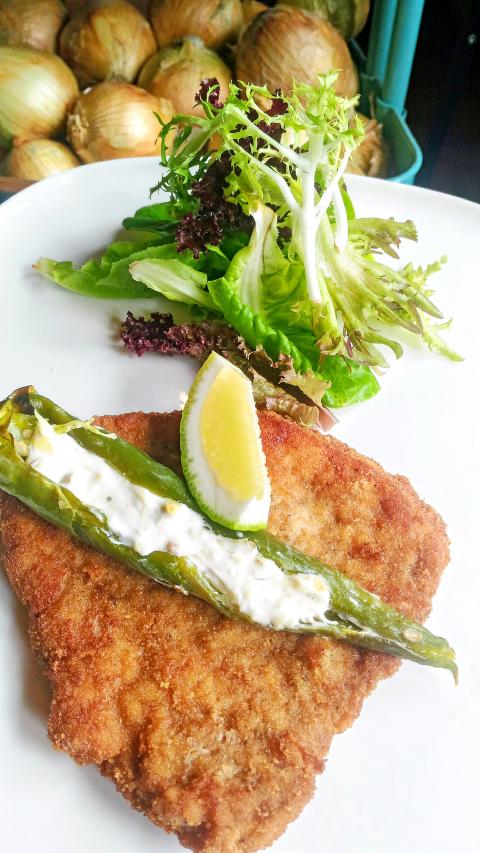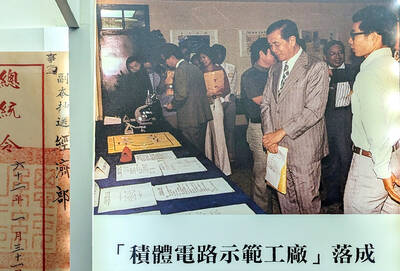You hear the word chili and immediately think of dishes that bring tears to the eyes and sweat to the brow. This is a delight to some, but a torment to others. In Taiwan, the food of China’s Sichuan or Hunan provinces comes to mind, with their tongue numbing power and vibrant crimson color scheme. But while the red-hots are the prima donnas of the chili world, their oft-neglected milder relatives have plenty to offer in terms of flavor. So now that various members of the wide-ranging clan called the genus Capsicum are hitting the market shelves in a big way, it is a chance to remember that there are many shy and retiring members who also deserve our attention.
Cow horn chilies (角椒) are one of these mild-mannered chilies that are widely available in Taiwan at the moment. They are most famously served in the dish of pork stuffed cow horn chilies (角椒鑲肉), a delicious and rather sophisticated side dish that balances a slightly sweet stuffing of minced pork with the very slight spice of the chilies. But cow horns have many applications, and I have used them for a slightly toned-down version of my Chicken Liver Picante (Taipei Times, Sept 3, 2016) to good effect.
These chilies look a little like emaciated green capsicum, with the same matte green coloring and oddly contoured lines, but built on a more elongated frame. While there is a resemblance, they are in fact from different families, and the capsicum is totally devoid of the chili’s signature element of capsaicin, which is what makes chilies “hot.” The green cow horns are a branch of the cayenne cultivar, which is probably best known as the dried spice cayenne pepper that is used to pep up many dishes in a wide variety of cuisines. The green cow horn chilies that I have come across so far have only had a very mild heat, but it is worth noting that the heat level of chilies can vary quite significantly even within the same variety. If you are sensitive even to slight heat, careful removal of the seeds, and particularly the white pith that holds the seeds, will keep the heat in check. The pith is where the capsaicin is most concentrated and its removal can greatly reduce the sharpness of the chili’s bite while preserving other flavors.

Photo: Ian Bartholomew
So even if you are not a big fan of spicy food, the cow horn and other similar chilies are a good source of the many good effects that chili has on our health and wellbeing. Chilies are excellent sources of many vitamins, particularly B group vitamins and also Vitamin C. Chinese medical lore attributes many good effect from the moderate ingestion of chili, not least as an aid to digestion and stimulating appetite, and medical science has come to support this with a number of studies showing long term health benefits of occasionally eating spicy food.
Pork Schnitzel with Yogurt Stuffed Cow Horn Chilies

Photo: Ian Bartholomew
Recipe
(Serves 4)
Wiener schnitzel is a much abused dish which doubtless has its grand traditions, but I am perfectly happy to put these aside in the interests of convenience and the consumption of breaded meat. The pork available in Taiwan is perfectly serviceable, and indeed delicious, substitute for the traditional veal, and while copious quantities of butter do indeed impart a luxurious richness to the final product, good, clean vegetable oil is easier to use and produces a result that is very acceptable without the danger of burnt butter. I generally have a quantity of strained yogurt in the fridge, which I usually salt for longer life, which is excellent for cooked dishes such as the stuffed chilies. It can get quite tangy, but for me this is part of the appeal. Feel free to use strained yogurt of more recent vintage. A good strong yogurt is a great counterpoint to the slight pungency of the chilies, and the bacon and cheese provide lovely depth of flavor, and the whole thing mashed over the breaded meat is one of my own perfect comfort foods.
Ingredients
For the cow horn chilies:
8 firm green cow horn chilies
200g strained yogurt, preferably homemade
100g grated cheese, such as Emmental or Gruyere
2 cloves garlic, finely minced
1 tbsp lemon juice
2 rashers bacon
For the schnitzel:
4 thick slices of pork loin (2.5cm is a good place to start)
1/2 cup flour
2 eggs
2 tbsp double cream
1 cup breadcrumbs*
salt and pepper to season
vegetable oil
wedges of lemon to garnish
Directions
1. Attack the pork loin slices with a meat hammer and beat them into submission. They should be about 5mm thick without any tears. Set aside.
2. Rub the cow horn chilies with a little oil and place them on a baking sheet. Grill at 230c for about 15 minutes, turning occasionally, until the skins are blackened and blistered. Remove and cover tightly with foil to let then steam in their own heat for another 20-30 minutes.
3. Fry the bacon in a little oil until crispy. Drain on kitchen paper and then break into pieces.
4. Mix the yogurt and cheese. (The yogurt should have the texture of cream cheese. If you feel it is too watery, strain it through cheesecloth of muslin to remove excess liquid.) Add the other seasonings and mix well.
5. When the chilies have cooled, their skins will have loosened. You can choose to peel the skins, or not, depending on how you feel. Removing the skins can be a bit fiddly, but provides a better texture to the final dish. The burnt skins can be quite attractive, providing some darker hues to the dish and a hint of bitterness to the taste, which is decidedly appealing.
6. Slit the chilies open and remove the seeds and some of the white pith. Fill with the yogurt mixture and put on a baking sheet and bake in a oven pre-heated to 190c for about 10 minutes.
7. While the chilies are baking, cover a plate with flour and another with the breadcrumbs. Make a mixture of the eggs and cream, beating lightly.
8. Take the well-beaten pork pieces and season generously with salt and pepper. Coat lightly in flour then dip into the egg mixture. Dredge in the breadcrumbs, coating thoroughly, but avoid pressing the meat too hard.
9. Heat a skillet with about 1cm of oil covering its base. Fry the schnitzels until golden brown, about 2 minutes a side. Place on kitchen paper to drain. Serve hot with the stuffed peppers and a wedge of lemon. Goes particularly well with a simple leaf salad.
* Breadcrumbs are easily made at home if you have an oven. Collect the tail ends of toast and freeze until you have a fair quantity. Place in an oven at about 120c and allow to dry out thoroughly then pop in a blender and whizz. These crumbs can be kept in the freezer for a couple of weeks.
Ian Bartholomew runs Ian’s Table, a small guesthouse in Hualien. He has lived in Taiwan for many years writing about the food scene and has decided that until you look at farming, you know nothing about the food you eat. He can be contacted at Hualien202@gmail.com.

Oct. 27 to Nov. 2 Over a breakfast of soymilk and fried dough costing less than NT$400, seven officials and engineers agreed on a NT$400 million plan — unaware that it would mark the beginning of Taiwan’s semiconductor empire. It was a cold February morning in 1974. Gathered at the unassuming shop were Economics minister Sun Yun-hsuan (孫運璿), director-general of Transportation and Communications Kao Yu-shu (高玉樹), Industrial Technology Research Institute (ITRI) president Wang Chao-chen (王兆振), Telecommunications Laboratories director Kang Pao-huang (康寶煌), Executive Yuan secretary-general Fei Hua (費驊), director-general of Telecommunications Fang Hsien-chi (方賢齊) and Radio Corporation of America (RCA) Laboratories director Pan

President William Lai (賴清德) has championed Taiwan as an “AI Island” — an artificial intelligence (AI) hub powering the global tech economy. But without major shifts in talent, funding and strategic direction, this vision risks becoming a static fortress: indispensable, yet immobile and vulnerable. It’s time to reframe Taiwan’s ambition. Time to move from a resource-rich AI island to an AI Armada. Why change metaphors? Because choosing the right metaphor shapes both understanding and strategy. The “AI Island” frames our national ambition as a static fortress that, while valuable, is still vulnerable and reactive. Shifting our metaphor to an “AI Armada”

The older you get, and the more obsessed with your health, the more it feels as if life comes down to numbers: how many more years you can expect; your lean body mass; your percentage of visceral fat; how dense your bones are; how many kilos you can squat; how long you can deadhang; how often you still do it; your levels of LDL and HDL cholesterol; your resting heart rate; your overnight blood oxygen level; how quickly you can run; how many steps you do in a day; how many hours you sleep; how fast you are shrinking; how

When Taiwan was battered by storms this summer, the only crumb of comfort I could take was knowing that some advice I’d drafted several weeks earlier had been correct. Regarding the Southern Cross-Island Highway (南橫公路), a spectacular high-elevation route connecting Taiwan’s southwest with the country’s southeast, I’d written: “The precarious existence of this road cannot be overstated; those hoping to drive or ride all the way across should have a backup plan.” As this article was going to press, the middle section of the highway, between Meishankou (梅山口) in Kaohsiung and Siangyang (向陽) in Taitung County, was still closed to outsiders